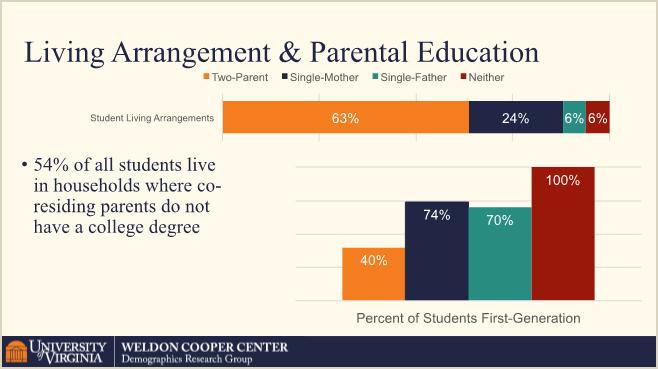Helping first-gen students: first find them in high school

As our nation embraces–and as the workplace demands–postsecondary education for an increasingly wider swath of students graduating from high school, the question arises: what factors discourage, or even prevent, high school students from applying for admission to Virginia’s many fine postsecondary institutions? Certainly, finances, family constraints, academic and career interests, and other issues may influence whether a high school senior undertakes the process of surveying schools of interest, collecting application forms, taking placement tests, and completing the complex process of submitting applications to one or more institutions of higher education. Many educators and policy makers assume that the level of education of the students’ parents may have a significant impact on whether students apply to college and on how well they do once admitted; and initiatives are developed to support these so-called “first generation” students, once they are enrolled in a college or university in the Commonwealth.
The available data on first generation status typically comes from self-reporting by students either in surveys of college applicants, or in questions answered as part of the biographical information collected when taking placement exams, such as the SAT. This data is limited in utility in that it excludes those high school students who neither apply to college nor take the SAT. Those students may be precisely the population we might seek to address if the goal is to help first generation student exceed the educational achievements of their parents.
In a recent research project, we used American Community Survey data to address these related questions:
- Can we identify students in high school who would be considered first generation college students if they applied and were admitted to a postsecondary institution?
- How many high school students in Virginia would be considered first generation?
- Does there appear to be any impact of having first generation status in college-going aspirations?
To answer these questions, as noted above, we needed a precise definition of first generation status among all students in high school (not just those applying to college or taking the SAT), and a data source that provides the information needed. Using American Community Survey data, we devised a proxy for first generation status, measuring how many high school students live in a household where no co-residing parent has a four-year college degree. Note: this definition counts a high school student as first generation if either of his or her parents had ever attended college but not completed a degree, or if one or both parents had an earned a two- (but not four-) year degree. While perhaps not a perfect indicator of first generation status, this definition and the American Community Survey data allow us to include all Virginia high school students in our effort to understand the prevalence of first generation status.
We began by selecting American Community Survey data on all households with high-school age students, and then examined the educational attainment of the parents by household type. If neither parent had a four-year college degree, we considered the student to be first-generation.
Of course, not all students live in a household with two parents. In fact, only 63 percent of Virginia high school students live in households with two parents present (including step-parents). Nearly one-quarter of high school students (24 percent) live in households with single mothers, six percent with single fathers, and another six percent with neither parent. (Among single parent or non parent households, educational attainment information for the absent parent was not reported on the American Community Survey, so we relied on the co-residing parent’s education to decide a student’s first-generation status. This approach, while not ideal, is still reasonable. The assumption is that, when a parent is absent from the household, the influence of his/her educational attainment may be weaker or nonexistent).
Among Virginia’s high school students living with two parents, 40 percent are in households where neither parent has a four-year degree. Among those who live with a single parent (either single mother or single father), the numbers rise to above 70 percent. Those who live with neither parent, by the definition applied in this study, are 100 percent first generation.

Combined, more than one-half (54 percent) of Virginia’s high school students live in households where co-residing parents do not have a four-year college degree.
Does first generation status have an impact on high school students and their college-going aspirations? To answer this question, we compared the 54 percent rate of first generation status overall to the rate of students taking the SAT and reporting first generation status. College Board data indicates that 30 percent of Virginia’s SAT takers of the 2015 class self-reported first generation status. If first generation status had no influence, we would expect that close of half of those students taking the SAT would report first generation status. (Note that the overall 54 percent is determined by American Community Survey data, as described above. The 30 percent reported by the College Board is students self-reporting as having first generation status. Certainly the definitions of first generation, as well as the accuracy of the data, may render comparisons between the two percentages not comparable). While firm conclusions evade us in the available data, the discrepancy suggests that SAT-taking (and perhaps college aspirations in general) may be depressed among first generation high school seniors.


